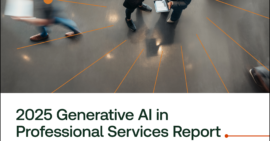The legal profession is in the midst of a transformation, driven by technological advancements, changing client expectations, and a growing need for efficiency. At the heart of this change are women in legal tech who are not only embracing innovation but actively shaping the future of legal work.
As we celebrate International Women’s Day 2025, we chatted with our colleagues at Thomson Reuters working in the legal solutions team. From AI adoption and legal automation to bridging the gap between law and technology, these women are redefining what’s possible in legal innovation. Their journeys highlight the impact of emerging technologies and the resilience, adaptability, and leadership that drive meaningful change in the profession.
From challenges to innovation: A personal journey into Legal Tech
For Alice Tsui, Senior Legal Editor at Thomson Reuters Hong Kong, innovation wasn’t just a career shift—it was a mission born out of firsthand experience. “As a former lawyer, I experienced first-hand the challenges and frustrations brought by inefficient processes,” she recalls.
“Having worked in the technology industry before, I became fascinated by technology’s potential to transform legal practice.” Alice knew there had to be a way to bring smarter technologies to the practice of law.
That realisation led Alice to the practice innovation team at an international law firm, where she developed tools to streamline legal processes. Now at Thomson Reuters, she is shaping trusted content of Practical Law. “The legal industry is undergoing unprecedented change, with innovation being essential for lawyers to remain competitive,” she emphasises.

For Stephanie Siu, Senior Legal Solutions Manager, the moment of reckoning came during a grueling COVID-era work schedule.
“I was an M&A lawyer, working on four due diligence projects during COVID lockdown and asking myself at 4am – surely there must be a more efficient way of doing things?! That moment sparked my curiosity to look into legal technology…and the rest is history.”
That moment led Stephanie to transition from law into legal technology. “The move wasn’t easy,” she admits.
“Leaving law for a tech startup, then later joining Thomson Reuters, felt like a leap of faith. But now, I find it incredibly fulfilling to speak with lawyers, and to be able to understand and resolve their exact pain points.”
She also teaches legal technology at two Hong Kong universities, mentoring students who represent the next generation of legal innovators.

AI in the legal sector: Empowering, not replacing lawyers
One of the biggest challenges in legal innovation is demystifying AI. Many lawyers remain skeptical of its capabilities, and without the right guidance, adoption can be slow. That’s why Catherine Roberts, Senior Director of AI & LegalTech APAC, led a series of AI workshops across Asia and the Middle East.
“Our AI Skills Challenges which took place in Singapore and Hong Kong were designed to create a safe and engaging space for lawyers to experiment with AI, test real-world applications, and better understand its opportunities and limits” she explains.
Catherine wanted to take AI from an abstract concept to a practical tool that lawyers can comprehend and confidently use.
Catherine believes that AI isn’t about replacing lawyers—it’s about freeing them from repetitive, mundane tasks so they can focus on high-value work.
“Burnout is a real issue in the profession,” she says. “AI can help by reducing the burden of mundane work, giving lawyers more time to engage in complex problem-solving, client interactions, and strategic thinking.”
Stephanie echoes this sentiment. “Technology should empower lawyers, not replace them,” she says. “If we use AI correctly, it enhances our work rather than diminishing our value.”

Career transitions and work-life balance
Innovation doesn’t just happen where the law is practiced—it’s also about rethinking career paths and work structures to support women in the profession. Sasa Lam, a Legal Content Solutions Consultant, understands this better than most.
“Balancing private practice with motherhood was one of the biggest challenges,” she shares. “After my child was born, I had to reassess my priorities.”
Lam transitioned from law firm life to a trainer role at Thomson Reuters, using her expertise to empower lawyers and students. More recently, she moved into a solutions consultant role, adapting to a whole new set of responsibilities.
“The support of my family, colleagues, and mentors was crucial in making these transitions successful,” she says.
“Women in law are incredibly resilient, and we bring that adaptability into everything we do—including legal innovation.”

Advice for women lawyers embarking on legal innovation
The role of women in legal innovation is growing, but there is still much work to be done. Stephanie has seen a surge of interest in legal tech from students.
“Three years ago, I had just seven students enrolled in my legal tech course. Today, I have over 30, and some are even building their own legal tech tools!”. This growing interest is a promising sign, but as Stephanie puts it, “We need more women in legal innovation.”
When asked about advice for young women looking to enter the field, the response was clear: “Be curious. Ask questions.”
Stephanie stresses that lawyers are trained to be over-prepared, and to not speak unless they have an answer. “But in legal innovation, no one has all the answers. What matters is asking the right questions, exploring new possibilities, and staying open to learning.”
Catherine agrees. “The most successful innovators aren’t those who know all the answers. They’re the ones who ask the right questions, experiment and adapt.”
For Sasa Lam, Legal Content Solutions Consultant, continuous learning and adaptability are the keys to long-term success. “The legal world is shifting. The women who stay ahead of technological advancements will be the ones leading the industry forward.”
Paving the way for a more inclusive legal industry
The experiences of these women highlight a fundamental truth: real innovation happens when legal expertise meets bold thinking.
From developing AI-driven legal tools to improving work-life balance structures, these women are not just adapting to change—they are driving it. Their work is creating a profession that is more efficient, sustainable, and inclusive for the next generation of legal professionals.
As Catherine puts it: “Legal technology isn’t about replacing lawyers—it’s about amplifying their impact. The more we embrace it, the stronger our profession becomes.”
With leaders like these at the helm, the future of law is just at the start of evolving.
Keen to know more about how AI and legal tech are shaping the legal practice? Register for the Thomson Reuters Hong Kong AI and Legal Tech Forum 2025 at JW Marriott Hong Kong, on 10 April 2025.
How Thomson Reuters Asia can help
Elevate your legal practice with Thomson Reuters’s premier suite of solutions. Experience the most advanced AI legal assistant in the market with CoCounsel and CoCounsel Drafting. Dive into our innovative tools like HighQ, Practical Law, Legal Tracker, and Westlaw to streamline your operations and gain critical insights. Revolutionize legal departments with smarter, faster decision-making capabilities.
Ready to transform your legal strategy? Request a free demo or trial, connect with us on LinkedIn, and subscribe to our Newsletter for the latest in legal innovation.


